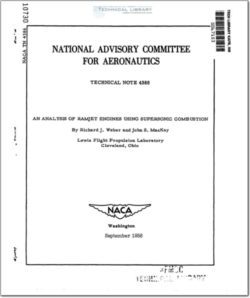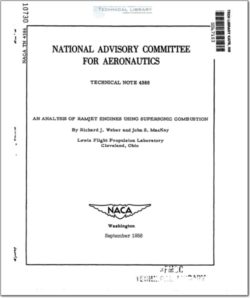NACA-TN-4386

- Version
- 182 Downloads
- 2.03 MB File Size
- 1 File Count
- March 24, 2016 Create Date
- March 24, 2016 Last Updated
National Advisory Committee for Aeronautics, Technical Notes - Use of the Kernel Function in a Three-Dimensional Flutter Analysis with Application to a Flutter-Tested Delta-Wing ModelAn Analysis of Ramjet Engines Using Supersonic Combustion

Based on the assumption that shock-free internal burning is possible
in a supersonic airstream, calculations are made for the performance of
ramjets using supersonic combustion velocities.
Diffusion of the air from the flight speed to a lower supersonic
velocity is generally found to be desirable before the air enters the
combustor. With a constant-area combustor, both maximum.thrust and over-
all engine efficiency are achieved when sufficient heat is added to choke
the flow at the combustor exit.
In the flight Mach number range considered, from 4 to 7, the over-
all efficiency of both the supersonic—combustion and the conventional
ramjet engines increases with flight speed. When compared with a con-
ventional engine having a two-cone inlet, the supersonic-combustion engine
with a Pitot inlet is less efficient at all speeds, with a wedge inlet
is more efficient above Mach 7, and with an isentropic inlet is more ef-
ficient above Mach 5. At Mach 7, the maxhnmm over-all efficiency is 45
and 54 percent for the wedge and isentropic inlets, respectively.
When simplified weight estimates are used, no weight advantage is
found for the supersonic-combustion engine, as compared with the con—
ventional ramJet.
In a conventional ramjet, air is captured and decelerated to a low
subsonic velocity by an inlet diffuser, after which heat is added in a
combustor. Inasmuch as adding heat to a supersonic stream decelerates
the flow and raises the static pressure, the possibility of replacing the
conventional ramjet inlet and combustor by a combustor having a supersonic
inlet velocity is thus suggested; this would compress the air thermo—
dynamically, coincidently with the heat release.
Burning in a supersonic stream must always cause a relatively large
total-pressure drop; whereas, at least ideally, the diffusion and sub-
sequent subsonic combustion in a conventional ramJet may be accomplished
with a vanishingly small total-pressure loss. In some cases, however,
the supersonic-combustion ramJet may prove to be more efficient than a
conventional ramJet that has finite diffusion losses. Another factor is
that the lower static temperatures associated with supersonic combustion
inhibit dissociation and thus reduce possible losses due to nonequilibrium
nozzle expansion. In addition, supersonic_combustion may tend to ease
the cooling problems of the conventional engine.
| File | Action |
|---|---|
| naca-tn-4386 An Analysis of Ramjet Engines Using Supersonic Combustion.pdf | Download |
Comment On This Post